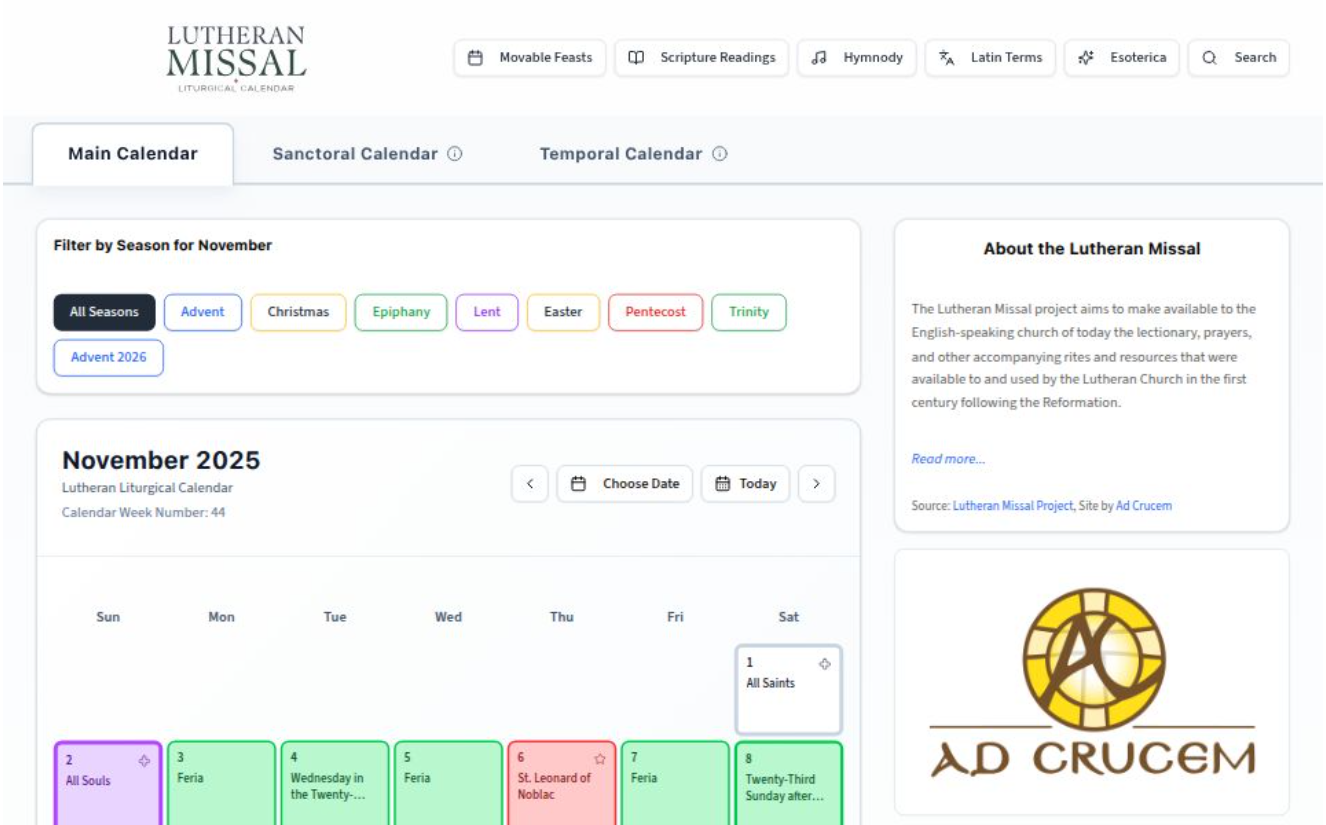A More Usable Way to Navigate the Lutheran Missal
How the Lutheran Missal Calendar App complements and improves upon the planning project team's spreadsheet.
The team researching and assembling the Lutheran Missal has graciously published its liturgical calendar for 2025-2026. Ad Crucem has used the data to deploy a free-to-use web application that will make the task of musicians, pastors, and lay planners much easier. Improvements will continue to be made going forward.
https://missal.adcrucem.app/
As the historic one-year lectionary continues to regain interest, the range of days and observances people want to keep track of has expanded, which is the strength of the Lutheran Missal. Weekdays, lesser feasts, Ember Days, octaves, and commemorations all benefit from a tool that shows how the Church Year actually looks as a calendar—not just how it reads in a list.
What the App Adds
The spreadsheet remains the reliable home for detailed planning—hymn numbers, readings, notes, and custom local information. But the app fills a different and complementary need: the ability to interactively explore the Church Year the way we actually live it, with tools that simply aren’t possible in a static spreadsheet.
1. A visual calendar, not rows and columns
Instead of scanning rows, the app presents each month as a normal calendar—Sundays, weekdays, feasts, vigils, and commemorations all displayed in their natural place. This gives immediate insight into:
where we are in a season
how major festivals anchor the month
how weekday observances relate to Sunday propers
how fasts and feasts cluster across time
Planning becomes intuitive rather than mechanical—a sense of liturgical rhythm rather than data management.
2. Click into each day for Scripture, hymns, and devotional material
Every date opens into a rich page of resources:
Full Scripture readings
Side-by-side Septuagint and Masoretic text comparisons (where relevant)
Linked hymnody, with tune help and connections to the propers
Devotional notes and liturgical context for the occasion
This makes weekday observances, family devotions, catechesis, and music preparation unusually accessible. You don’t search or filter—you simply tap the date.
3. Tools for exploring the entire Church Year
Beyond the grid, the app includes:
Season filters (Advent, Lent, Easter, etc.)
Temporal and Sanctoral views
A Moveable Feasts Calendar through 2054 for long-term planning
A Latin glossary, defining every Latin term appearing in the calendar
A Biblical Esoterica section showing patterns, statistics, and interesting analyses drawn from Scripture
These features deepen understanding, reveal connections, and invite exploration.
4. Built for every device and every context
While the spreadsheet is best on a desktop, the app is fully at home on:
phones (quick checks before a service)
tablets (ideal for musicians and teachers)
desktops (study, planning, or preaching prep)
This flexibility makes it useful not only weekly but daily—during pastoral visits, rehearsal planning, study groups, or personal devotion.
How the Spreadsheet and App Work Together
The app doesn’t replace the spreadsheet—it activates it.
A natural workflow looks like this:
Use the app to locate a Sunday or feast, read the Scriptures, compare texts, and preview hymnody.
Use the spreadsheet for bulletin preparation, choir schedules, inserts, service folders, and recording what your parish actually uses.
Use the app for weekday observances and a lived sense of the Church Year’s contours.
Use the spreadsheet for printing, archiving, analytics, and local customization.
Together the two options offer a more complete, usable, and immersive way to pray, plan, teach, and inhabit the Church Year, whether as a pastor, musician, catechist, or household.




As a relatively new Lutheran (and a closet Anglican while attending a Presbyterian church for the last 20+years), I find this pretty interesting. You've put in lots of work (I'm guessing--not familiar with your input source--but, as someone who's last job involved html/css/JavaScript, it looks like it would have taken quite a few hours of work). However, it seems strange that some Fridays are labeled as Saturday, some Thursdays are labeled as Friday, some Tuesdays are labeled as Wednesday, etc. I'm guessing it must have something to do with the old 0-base/1-base problem...
Lovely!
Would you ever consider adding support for the CCA's Congregation at Prayer schedule? Wonder how hard it would be to clone/extend.
https://www.lutherancatechesis.org/